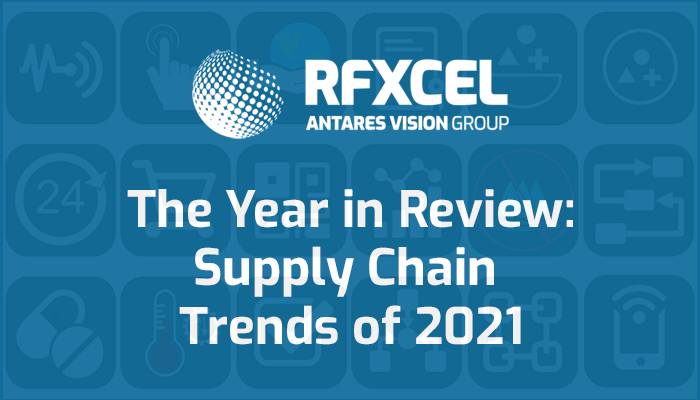The supply chain has been grabbing headlines since the pandemic began, but this year was especially newsworthy. From flotilla-like bottlenecks at major U.S. ports to warnings about counterfeit toys in Santa’s sleigh, it’s been a challenging time for supply chain stakeholders and consumers alike. So, as the year winds down, we thought we’d take a look at some of the top supply chain trends of 2021.
The year’s supply chain trends
Before we start, please note that this isn’t a ranked list or a “countdown” to the No. 1 supply chain trend of the year. It’s just a collection of trends that have occurred in different industries and that have made industry news as we’ve worked our way through the year. That said, without further ado, here are the top supply chain trends of 2021.
Automation
Automation includes robotics, machine learning, artificial intelligence, process mining, drones, and driverless delivery systems. This trend dates back to the first half of 2019, when companies in North America spent $869 million on more than 16,000 robots. This year, the World Robotics 2021 Industrial Robots report said there were 3 million industrial robots operating in factories globally, a record number and an increase of 10 percent. The report also said sales of new robots grew 0.5 percent, with 384,000 units shipped globally in 2020.
Blockchain
Blockchain has been a buzzword for years, and worldwide spending on the technology has been predicted to reach more than $11 billion by 2022. In regard to supply chain management, blockchain has great potential for traceability because it allows the provenance of any product to be easily demonstrated with and supported by immutable, tamper-proof data. It’s a big topic, so download our “Blockchain-Based Supply Chain Traceability” white paper to learn more.
Sustainability
There’s been a barrage of research about supply chain sustainability, particularly consumers’ expectations for transparency and environmentally friendly products and packaging. In one recent survey, 83 percent of respondents said it was “important or extremely important” for companies to design environmentally conscious products. Another found that 81 percent of shoppers say transparency is important or extremely important to them. In short, more companies are choosing to make their supply greener and more transparent.
Consumer engagement/customer experience
Consumer engagement and customer experience have always had a place in marketing and branding, but they’ve risen to a priority position over the last several years. (See a tidy summary of why here.) But what does your supply chain have to do with any of this?
The short answer: Your supply chain is a gold mine of information that can be leveraged for robust, innovative engagement/experience strategies. The basic building block is serialization. Read our two-part series to learn more. And definitely read our article about how supply chain traceability is building a “consumer kingdom.”
“The Trifecta”: Traceability, Visibility, Transparency
It should come as no surprise that we’re including these three “must-haves” on our list of the top supply chain trends in 2021. We’ve always maintained that visibility, transparency, and traceability are the key to a successful supply chain; however, the last two years have shown us that this trifecta is more important than ever and is the best way to optimize, safeguard, and leverage your supply chain for business value.
Visibility means using data to gain insight into how your supply chain is functioning and to take steps to make it run more efficiently. The goal is to see every ingredient/input, every product, every partner, every handoff … everything. Transparency means communicating supply chain knowledge internally and externally so all stakeholders, including consumers, can see how you operate. Traceability means you can follow a product to its point of origin and prove what it is and where it came from.
We have written extensively on these topics. Here’s a suggested reading list:
Internet of Things (IoT)
IoT is a network of physical objects that connects to the internet via sensors and software. It’s the basis of our Integrated Monitoring solution. It enables greater visibility and flexibility across your entire supply chain. For example, IoT-enabled sensors placed in a shipment of vaccines will send a real-time alert if a problem arises, such as a temperature excursion or route diversion. We’ve written about IoT in the food and beverage industry, and rfxcel CEO Glenn Abood wrote a great article about real-time monitoring in the pharma cold chain. We also have a great video about it.
Digitization
If we were ranking the 2021′ supply chain trends, we’d make digitization No. 1. A supply chain that isn’t digitized cannot function efficiently. It cannot give consumers what they demand. It cannot comply with regulations. It cannot compete. It cannot make your business better.
Final thoughts
As we move toward the New Year, it’s a good time to think about the future of your supply chain. Ask yourself some basic questions:
-
- Are you keeping up with the trends we talked about today?
- Are there gaps and blind spots in your supply chain?
- Are counterfeits a problem in your industry?
- Are you doing everything you can to protect your brand?
- Are you actively reaching out to your customers to bring them closer to your brand?
- Are there compliance deadlines on the horizon?
- Are you certain your current supply chain solutions are truly optimal?
- Are you using your supply chain as a strategic asset?
The next step is to contact us. Our digital supply chain experts can share a short demo of our award-winning Traceability System that will clearly show why it’s the best solution for any business, under any circumstances.





